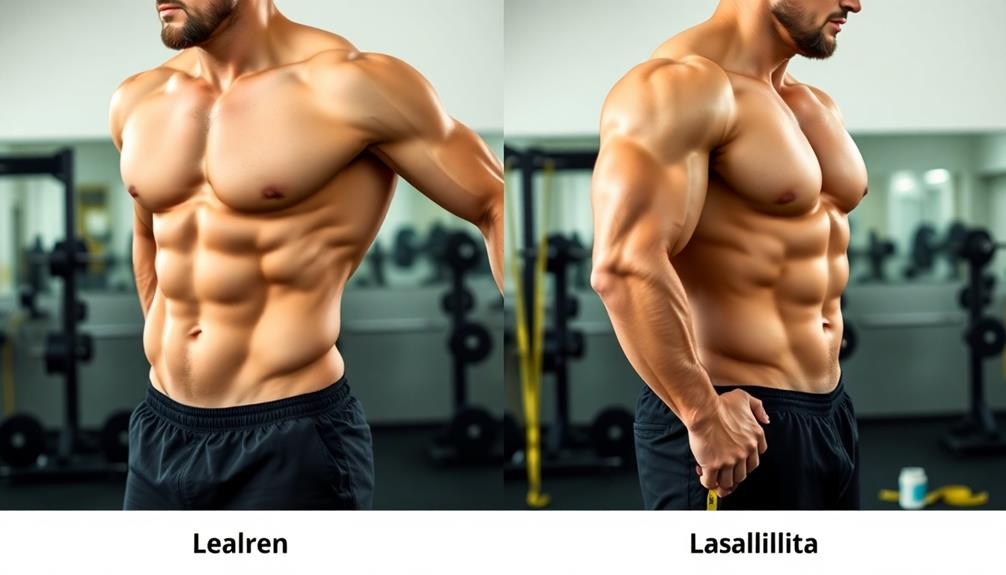When choosing between getting shredded or bulking up, you'll encounter key differences in your fitness journey. Shredding requires a calorie deficit, while bulking needs a surplus. Your macronutrient balance will shift, with more protein for cutting and increased carbs for bulking. Workout intensity and volume vary, as does your cardio routine. Rest and recovery needs differ, and you'll see results on different timelines. Your diet will be more flexible when bulking, but stricter for shredding. Both paths present unique mental challenges and sustainability concerns. Understanding these distinctions will help you make an informed decision about your fitness goals and long-term health.
Core Insight
- Calorie intake differs: shredding requires a deficit, while bulking needs a surplus of 300-500 calories daily.
- Workout intensity varies: shredding involves higher intensity with less rest, bulking uses moderate intensity with longer rests.
- Cardio frequency changes: shredding requires more cardio (3-5 times weekly), bulking needs less (1-2 times weekly).
- Muscle development focus: shredding aims for definition with higher reps, bulking targets size with lower reps and heavier weights.
- Dietary considerations: shredding emphasizes lean proteins and veggies, while bulking allows more food variety and carbs.
Calorie Intake

Calorie intake is one of the biggest differences between shredding and bulking. To get shredded, you need to eat fewer calories than your body burns. This calorie deficit makes your body use fat for energy, helping you lose fat and show off your muscles. After working out, eat foods with carbs that digest quickly to give you energy and help you recover without eating too many calories.
Bulking is the opposite. You need to eat more calories than your body burns to build muscle and gain weight. The extra calories give your body what it needs to grow muscle and get bigger.
The amount of calories you need to change depends on your goal. For shredding, eat about 300-500 fewer calories per day. For bulking, eat about 300-500 more calories per day, focusing on foods that are packed with nutrients to help your muscles grow.
Macronutrient Balance

When changing your macronutrient ratios, you'll need different strategies for cutting fat and building muscle. To get lean, increase your protein to about 1.2-1.6 grams per pound of body weight to maintain muscle while losing fat. Lower your carbs to burn more fat, but keep eating moderate amounts of healthy fats. Consider taking HMB supplements during your cut to help preserve muscle mass.
For bulking, you'll have to eat more calories overall, especially from carbs, to fuel muscle growth. Aim for 2-3 grams of carbs per pound. Keep protein high at around 1 gram per pound to support muscle gains. Include healthy fats too, as they're important for hormones and overall health.
Workout Intensity and Volume

Your workout intensity and volume will be quite different depending on if you want to get shredded or bulk up. To get shredded, do high-intensity workouts with short rest times. This burns the most calories while keeping your muscle. To bulk up, do moderate to high-intensity workouts but with longer rests. This helps your muscles grow.
Shredding:
- High intensity
- Lower volume
- Shorter rests
- More cardio
Bulking:
- Moderate to high intensity
- Higher volume
- Longer rests
- Less cardio
For shredding, add in more cardio and circuit training to lose fat faster. For bulking, focus on heavy compound lifts and gradually increasing the weight over time. This triggers muscle growth. Make sure your workout plan matches your specific goal. This is key for getting the best results.
Cardio Requirements

Cardio is different when you want to get shredded versus when you want to bulk up. If you're trying to get shredded, you need to do more cardio. This helps you burn more calories and lose extra fat, so your muscles show more. You might do cardio 3-5 times a week for 30-45 minutes each time. Some supplements with thermogenic ingredients can help give you more energy and recover better during tough cardio workouts.
But if you're trying to bulk up, you should do less cardio so you don't lose the extra calories you need to build muscle. Too much cardio can make it harder to gain muscle. When bulking, you'll usually do 1-2 short cardio workouts each week. These should be high-intensity interval training (HIIT) to speed up your metabolism without losing muscle. These workouts might be 15-20 minutes long, which is just enough to keep your heart healthy but not so much that it stops your bulking progress.
Rest and Recovery

Rest and recovery are different for people trying to get shredded versus those trying to bulk up. If you're cutting, you'll need more rest between workouts. This helps prevent muscle loss and keeps your energy up. Your body's working hard to burn fat but also keep muscle. Sleep is very important. Try to get 7-9 hours each night. This helps balance your hormones and recover.
If you're bulking, you usually need less rest between workouts. Your body has extra resources, so it's easier to recover and grow. But don't skimp on sleep. It's still crucial for muscle growth and overall health. You might find you need more total sleep to keep up with the extra work your body is doing.
Either way, pay attention to your body. Adjust your rest time if needed. Proper recovery is key to reaching your fitness goals, whether you want to get shredded or bulk up.
Muscle Definition vs. Size

Rest is essential, but how you train largely determines if you'll achieve muscle definition or size. For definition, use lower weights with more reps, do more cardio, and maintain a calorie deficit. To gain size, lift heavier weights with fewer reps and eat more calories than you burn. Check out this simple comparison:
| Aspect | Definition | Size |
|---|---|---|
| Reps per set | 12-15 | 6-8 |
| Weight lifted | Lighter | Heavier |
| Cardio frequency | More often | Less often |
| Calories eaten | Less than burned | More than burned |
| Rest time between sets | Shorter | Longer |
Time Frame and Progression
Trimming and building are two different fitness goals that require different approaches and timelines. When trimming, you can usually see results in 8-12 weeks. The focus is on losing about 1-2 pounds per week. As you progress, you'll notice more muscle definition and less body fat. Taking BCAA supplements can help your muscles recover and maintain muscle mass while you're eating fewer calories. This is especially helpful when trying to keep muscle while losing fat.
Building muscle takes longer – usually 3-6 months or more. You'll measure progress by how much stronger you get and how much muscle you gain. The number on the scale will go up, but the goal is to gain mostly muscle, not too much fat. During a building phase, you'll slowly increase how many calories you eat and change your workouts to help your muscles grow. Both trimming and building take time and consistent work to get the best results.
Dietary Flexibility

When you're bulking up, you have more flexibility with your diet compared to when you're trying to get lean and shredded. During a bulking phase, you can eat a bigger variety of foods and even treat yourself from time to time without messing up your progress. You'll typically:
- Eat more calories overall
- Add more carbs to your meals
- Enjoy the occasional treat guilt-free
You can also use weight gain supplements to get extra calories and nutrients to help build muscle.
But when you want to get shredded, you need to be stricter with your food choices. Focus on eating lean proteins, veggies, and measured portions of complex carbs. This tighter control helps you eat fewer calories to lose fat while keeping your muscle.
Mental Challenges

The mental game is just as important as the physical work when it comes to reaching your fitness goals. Whether you're trying to gain muscle or lose fat, you'll face challenges.
When bulking, you might struggle with gaining weight, even if it's mostly muscle. You may feel bigger or less defined, but it's important to stay focused on your goals and trust the process.
If you're trying to lose fat, you'll have to deal with feeling hungry and having less energy. You might also have mood swings because you're eating less. It can be hard to stay motivated when progress slows down. You'll also have to be disciplined with your diet and resist pressure from others to eat unhealthy foods.
No matter your goal, it's key to set realistic expectations and celebrate small victories along the way. Remember, being mentally strong is just as crucial as being physically strong when working towards your ideal physique.
Long-Term Sustainability

When thinking about your fitness goals, it's important to consider how sustainable they are over time. Shredded and bulking goals can be very different in terms of how easy they are to maintain long-term. As you reflect on your fitness journey, keep in mind:
- How well your approach fits with your daily life and schedule
- Possible long-term health impacts of extreme body goals
- How much effort you'll need to keep up your desired physique
Be sure to think about the guidelines from fitness professionals before starting any extreme fitness plan. This helps make sure you're being safe and ethical.
Shredded physiques usually require strict dieting and consistent training, which can be hard to keep up forever. Bulking allows more flexibility but might cause unwanted fat gain if not managed well. Choose a path that matches your long-term health and lifestyle goals. This way, you can maintain your progress without getting burned out or frustrated.
Frequently Asked Questions
Can I Switch Between Bulking and Shredding Cycles? How Often?
Yes, you can switch between bulking and shredding cycles. It's called "body recomposition." You'll typically want to spend 3-6 months on each phase. Listen to your body and adjust based on your progress and goals.
What Supplements Are Most Beneficial for Shredding Versus Bulking?
For shredding, you'll benefit from fat burners, caffeine, and BCAAs. When bulking, focus on protein powders, creatine, and mass gainers. However, don't rely solely on supplements; they're meant to complement your diet and training.
How Does Age Affect the Ability to Bulk or Shred Effectively?
As you age, your metabolism slows down, making it harder to shed fat. You'll also lose muscle mass naturally, which can impact bulking efforts. However, you can still achieve results with proper nutrition and tailored workout routines.
Are There Specific Body Types Better Suited for Bulking or Shredding?
You'll find that body types can influence your approach. If you're naturally lean (ectomorph), bulking may be easier. If you're stockier (endomorph), shredding might come more naturally. Mesomorphs often excel at both processes.
How Do Hormones Impact the Success of Bulking and Shredding Phases?
Hormones greatly impact your bulking and shredding success. They'll influence muscle growth, fat storage, and metabolism. During bulking, you'll want higher testosterone and insulin levels. For shredding, you'll benefit from increased growth hormone and cortisol.

